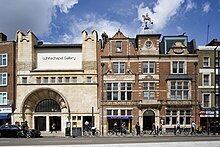Whitechapel Art Gallery
 |
|
| Established | 1901 |
|---|---|
| Location |
Whitechapel High Street London, E1 United Kingdom |
| Coordinates | 51°30′58″N 0°04′14″W / 51.515984°N 0.070485°WCoordinates: 51°30′58″N 0°04′14″W / 51.515984°N 0.070485°W |
| Visitors | 490,000 (April 2009 – April 2010) |
| Director | Iwona Blazwick |
| Public transit access |
|
| Website | whitechapelgallery.org |
The Whitechapel Gallery is a public art gallery on the north side of Whitechapel High Street, in the London Borough of Tower Hamlets. Designed by Charles Harrison Townsend, it was opened in 1901 as one of the first publicly funded galleries for temporary exhibitions in London, and it has a long track record for education and outreach projects, focused on local people. It exhibits the work of contemporary artists, as well as organising retrospective exhibitions and shows that are of interest to the local community.
The Whitechapel Gallery exhibited Pablo Picasso's Guernica in 1938 as part of a touring exhibition organised by Roland Penrose to protest against the Spanish Civil War.
The Whitechapel Gallery played an important part in the history of post-war British art, several important exhibitions were held at the Whitechapel Gallery including This is Tomorrow in 1956, the first UK exhibition by Mark Rothko in 1961, and in 1964 The New Generation show which featured John Hoyland, Bridget Riley, David Hockney and Patrick Caulfield among others.
Initiated by members of the Independent Group, the exhibition brought Pop Art to the general public as well as introducing some of the artists, concepts, designers and photographers that would define the Swinging Sixties.
Throughout its history, the Whitechapel Gallery had a series of open exhibitions that were a strong feature for the area's artist community, but by the early 1990s these open shows became less relevant as emerging artists moved to other areas.
...
Wikipedia

